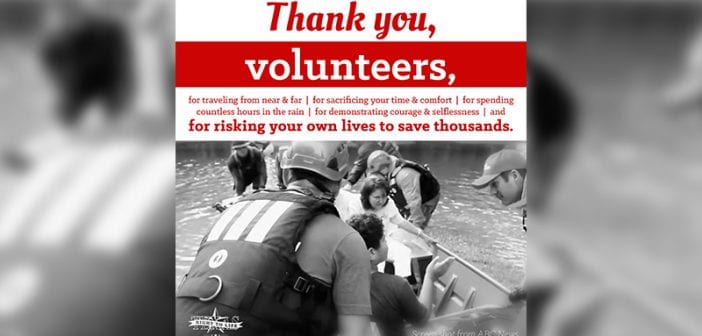Volunteers, law enforcement officers, and every day citizens worked together to save as many lives as possible from catastrophic flooding. In the wake of Harvey, normal citizens did everything they could to save the lives of others. These responders risked exposure to “drowning, alligators, and snakes,” but persisted in their efforts to save families from their flooded homes. Several responders travelled from distant cities to help in search and rescue efforts. A highly viewed video shows a YouTube star from Boerne, Texas travelling east on I-10 just inside the West Sam Houston Parkway in the middle of the night to prepare for rescues the following morning. These responders embarked on a difficult journey, but their journey was made easier by technology and innovation.
Citizens and responders used #SOSHarvey and #SOSHouston to request rescue from the impeding floodwaters, while officials responded to these requests with military-style vehicles. Technology played a great part in saving lives from catastrophic flood waters. Responders also used the mobile app zello, which changes any smart phone into a long-distance radio. After being rescued or making their way out of water-logged houses citizens returned home to see what damage was done.
After flood water receded, families returned to their homes to assess damage and remove as much debris as possible. Several homes were completely submerged in water, while others stood apart from the water as islands. Flood water partially submerged several neighborhoods, and these are the neighborhoods in which the recovery process starts. As rescue efforts continue and the recovery process begins, the horror of Harvey’s record-setting rainfall diminishes against the unity of society toward the goal of saving and protecting Life.
On August 23, The Washington Post reported, “The weather system previously known as Tropical Storm Harvey has begun to reorganize over the Gulf of Mexico and is expected to slam into Texas’s coast Friday, unloading dangerous amounts of rain.” Most models of the storm forecasted Harvey making landfall as a category 1 hurricane and bringing 15- 20 inches of rain. These forecasts, which were considered extreme at the time, are nothing compared to the reality of Harvey’s devastation — a reality that covers over 250 square miles of flooding, and brings at least $23 billion in property damage; a reality that has taken 46 confirmed lives, flooded 136,00 structures, and turned 46,00 Texans into evacuees; a reality that continuously howls in the faces of affected citizens — a reality that is overcome by courageous and selfless responders.
Thank you, responders, for risking your lives to save others. Our prayers are with all affected by Harvey and involved in the recovery efforts.

